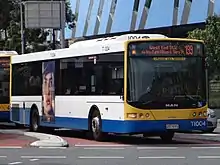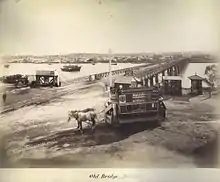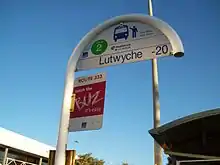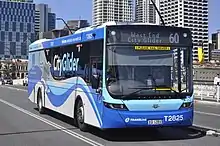Transport for Brisbane
Transport for Brisbane, previously called Brisbane Transport, is an organisational division of the Brisbane City Council, responsible through its related Council Committee for providing policy and advice to Brisbane City Council, and for delivering various public transport services across the City of Brisbane.[3][4][5] The division does this as part of an agreement with TransLink, an agency of the Department of Transport and Main Roads that operates public transport across South East Queensland.[6]
 A Transport for Brisbane-operated bus | |
| Division overview | |
|---|---|
| Preceding division |
|
| Jurisdiction | City of Brisbane, Australia |
| Headquarters | 266 George Street, Brisbane[1] |
| Division executive |
|
| Parent department | Brisbane City Council |
| Website | brisbane |
History

The origins of Transport for Brisbane (formerly, Brisbane Transport) can be traced to August 1885 where the Metropolitan Tramways & Investment Company established a service in Brisbane under franchise from the Queensland Government with 18 horse trams. The tram system remained in private hands until January 1923 when the Queensland government established the Brisbane Tramways Trust, compulsorily acquiring the tram network and supporting infrastructure, then in 1925 creating the Brisbane City Council and transferring responsibility for the tram network to the council. Before the council withdrew support in 1961, the council supported the tram network by expanding it to a peak of 175 kilometres (109 mi) with over 400 trams.[7]
Bus services commenced in 1925 by the Brisbane City Council.[8] Brisbane City Council shut down bus services due to financial loss in November 1927. Bus services recommenced 13 years later, in July 1940 with 12 Albion Valkyries.[8][9] In 1948 the Brisbane City Council acquired 20 operators with 67 buses.[7]
The first Rocket services began on the morning of 18 April 1977 between Garden City and the Brisbane CBD.[10] These services were based on the idea that bus travel time could be reduced to less than the travel time by car by the removal of most embarkation stops.
In the 1990s, Brisbane City Council corporatised its transport services to form Brisbane Transport, a council-owned commercial businesses managed at arm's length from the council and providing consultancy services back to it.
Infrastructure
Transport for Brisbane operates services along dedicated busway infrastructure to avoid peak hour traffic congestion on roads closest to the Brisbane CBD.
Services
Bus upgrade zone

Bus upgrade zones (BUZ) are high-frequency bus routes mostly running direct to the Cultural Centre. All BUZ services run at least every fifteen minutes from around 06:00 to 23:00 seven days a week and at least every ten minutes during peak hours from Monday to Friday.[11][12]
CityGlider

CityGlider is a high frequency pre-paid bus service around the Brisbane CBD, operating every five minutes during peak and every 10 to 15 minutes during off-peak. This is the first service in Brisbane to operate 24 hours on Friday and Saturday and 18 hours every other day.[13] Bus stops serviced by the CityGlider are identified with signs and painted kerb.
Clem7
Clem7 (Route 77) is a bus route using the Clem Jones Tunnel (Clem7) which links the suburbs of Eight Mile Plains and Chermside. It runs every 15 minutes at peak times and 30 minutes off-peak, Monday to Friday.[14]
The route commenced on 22 March 2010 at a cost of $1.6 million per annum. It has decreased the journey time between Eight Mile Plains and Chermside, removing the need to transfer at Cultural Centre. The route completes the 30 kilometres (19 mi) cross-city journey in 39 minutes instead of up to 55 minutes via the Brisbane CBD.[14]
Fleet
Two-axle buses
MAN 18.310s, Volvo B7RLEs and later Volvo B8RLEs make up the majority part of two-axle bus fleet of Brisbane Transport.
A total of 390 18.310s joined the Brisbane Transport fleet from 2005 to 2010, with 324 fitted with CNG engines (Fleet numbers 1200 to 1523) and 66 powered by diesel (Fleet numbers 1001 to 1066). Buses 1001 to 1015 are operating at South West Transit, 1019 to 1029 are serving Hornibrook Bus Lines services. CNG powered buses are starting to pull off from service starting from 2019.
The rest of the regular rigid fleet are all Volvos, including 553 diesel-powered B7RLEs (delivered from 2009 to 2018, fleet numbers 1801 to 2353). over 113 Volvo B8RLEs (delivered from 2017 on, fleet numbers 2801 onwards) and one Volvo B5RLEH Hybrid demonstrator bus (introduced in 2015, fleet number 1595), all low-floor, accessible and air-conditioned.
In October 2020, the last Scania L94UB, the first CNG (Compressed Natural Gas) and low floor bus was retired after 20 years of service. In total 217 were made with two lost due to accidents in 2003 and in 2009 when the bus exploded due to a problem with the CNG engine. This has lead the Brisbane City Council to retire all gas powered buses by 2027. [15] [16]
Three-axle buses
BT operates two models of three-axle "tag" buses, 8 Scania K310UB (delivered in early 2009, fleet numbers 1701 to 1708 and later renumbered as 5001 to 5008) and 149 Volvo B12BLE (delivered from 2010 to 2013, fleet numbers 5009 to 5157), both diesel-powered and delivered from 2009 on. These larger buses are used on high-demand trunk routes, mostly on the South East Busway.
Articulated buses
Articulated buses currently used by Transport for Brisbane are 30 CNG-powered MAN NG313s (Fleet numbers 1601 to 1630), delivered from 2007 to 2008 and 20 diesel-powered Volvo B8RLEAs (Fleet numbers 1631 onwards), delivered in 2018.
A further batch of B8RLEAs has started to deliver in early 2020, while the first two buses have entered service. The other buses will be used to upgrade the service of Blue CityGlider Route 60.
 Transport for Brisbane Scania L94UB (G676) at University of Queensland Interchange after completing a 209 service from the Carindale Interchange. The last bus of this type was retired in October 2020.
Transport for Brisbane Scania L94UB (G676) at University of Queensland Interchange after completing a 209 service from the Carindale Interchange. The last bus of this type was retired in October 2020..jpg.webp) A Brisbane Transport MAN 18.310 (G1276) powered by CNG doing the 590 to Toombul.
A Brisbane Transport MAN 18.310 (G1276) powered by CNG doing the 590 to Toombul..jpg.webp) Transport for Brisbane MAN 18.310 (T1030) powered by Diesel. This bus was painted in CityGlider livery starting from 2010 and operated on the Blue CityGlider 60 service until early 2019 when new Volvo B8RLEs were introduced to the route.
Transport for Brisbane MAN 18.310 (T1030) powered by Diesel. This bus was painted in CityGlider livery starting from 2010 and operated on the Blue CityGlider 60 service until early 2019 when new Volvo B8RLEs were introduced to the route. A Custom Coaches MAN NG313F CNG at Brisbane
A Custom Coaches MAN NG313F CNG at Brisbane A Transport for Brisbane Scania K310UB6x2 (G5002) at the Garden City interchange after completing the 180 route.
A Transport for Brisbane Scania K310UB6x2 (G5002) at the Garden City interchange after completing the 180 route. A Transport for Brisbane Volvo B7RLE (C1918), based at Carina, doing the 215 route towards Carindale.
A Transport for Brisbane Volvo B7RLE (C1918), based at Carina, doing the 215 route towards Carindale._(V2268).jpg.webp) A Transport for Brisbane Volvo B7RLE (V2268) based at the Virginia Depot. This model has a newer body and it is called Optimus.
A Transport for Brisbane Volvo B7RLE (V2268) based at the Virginia Depot. This model has a newer body and it is called Optimus. A Transport for Brisbane Volvo B8RLE, T2804, seen here at Mt Coo-tha heading towards the city.
A Transport for Brisbane Volvo B8RLE, T2804, seen here at Mt Coo-tha heading towards the city. A Transport for Brisbane Volvo B8RLEA at Upper Mt Gravatt interchange doing the 111 route to Roma Street.
A Transport for Brisbane Volvo B8RLEA at Upper Mt Gravatt interchange doing the 111 route to Roma Street. A Transport for Brisbane Volvo B12BLE (S5096) at the UQ interchange about to start the 66 route.
A Transport for Brisbane Volvo B12BLE (S5096) at the UQ interchange about to start the 66 route..jpg.webp) A Transport for Brisbane Mercedes Benz O500LE (C613), completing the 200 route from Carindale Heights to Queen Street Mall Interchange. The 0500LE was retired by Transport for Brisbane in 2013.
A Transport for Brisbane Mercedes Benz O500LE (C613), completing the 200 route from Carindale Heights to Queen Street Mall Interchange. The 0500LE was retired by Transport for Brisbane in 2013. A Transport for Brisbane Volvo B10M mk3, C261, doing the 220 route towards Wynnum. This type of bus was retired from the company in 2015.
A Transport for Brisbane Volvo B10M mk3, C261, doing the 220 route towards Wynnum. This type of bus was retired from the company in 2015.
Historic
Until the mid-1970s, heavy-duty AEC and Leyland buses were purchased. Later purchases were from European suppliers, Volvo B59s being purchased from 1976, MAN SL200s in 1982 and Volvo B10Ms from 1987.[7]
Depots
Transport for Brisbane operates its services from seven depots for specified areas. Some of these depots service routes shared in overlapping areas with other depots. Generally, each of Transport for Brisbane's buses is allocated to a particular depot, displaying a letter prefix for that depot before its fleet number, and hence is assigned to specific routes.
| Depot | Letter Code | Location | Opened | Services / Comments | Ref(s) |
|---|---|---|---|---|---|
| Carina | C | 27.490371°S 153.102078°E | 1969 | All eastern routes and some south-eastern routes from Garden City to Wynnum and Bulimba, Maroon CityGlider 61. | [17] |
| Eagle Farm | E | 27.427984°S 153.086427°E | 2013 | Some northern routes; all routes between New Farm and West End, Free Loops 40 and 50, Blue CityGlider 60, QUT Shuttle 391. | [17] |
| Garden City | G | 27.56655°S 153.086731°E | 1994 | South-eastern routes from Browns Plains and Sunnybank to Wishart and Coorparoo. This depot is also the location of Brisbane Transport's head office. | [17] |
| Sherwood | S | 27.53504°S 152.98909°E | 2012 | Western, south-western and north-western routes. | [17] |
| Toowong | T | 27.479235°S 152.983482°E | 1967 | South-western and north-western routes from Brookside and The Gap to Inala and Forest Lake, Free Loop route 30. | [17] |
| Virginia | V | 27.365889°S 153.060885°E | 1998 | Most northern routes from Nudgee Beach and Brighton to Brookside and the Gap. | [17] |
| Willawong | W | 27.598531°S 153.004103°E | 2009 | Primarily southern routes, some shared with other southern depots. | [17] |
Former depots
| Depot | Letter Code | Location | Opened[18] | Closed | Services / Comments | Ref(s) |
|---|---|---|---|---|---|---|
| Bowen Hills | A | 27.435975°S 153.042313°E | 2000 | 2013 | Some northern routes; all routes between New Farm and West End. Closed in 2013 with the opening of the new depot at Eagle Farm. | [19] |
| Richlands | R | 27.601259°S 152.957395°E | 1997 | 2013 | A satellite depot of the Toowong depot, it shared services on western routes, and some services to Garden City. | [20] |
| Larapinta | L | 27.643171°S 153.007364°E | 2007 | 2012 | A satellite depot of Carina, Garden City and Willawong depots, it shared southern, western and eastern services. Originally a temporary bus depot until the Willawong depot opened, it remained open as a satellite depot, sharing routes with other southern depots, until 20 February 2012. | |
| Bracken Ridge | B | 27.331658°S 153.02982°E | 1996 | 2001 | Only ever intended as a short-term depot, it was closed in 2001, several years after the Virginia depot had opened. | |
| Cribb Street, Milton | - | 27.469226°S 153.007858°E | ? | 1983 | Never a formal depot, the site was occasionally used as temporary storage for buses owing to its proximity to the Milton bus and tram workshops. Last used in 1983. | |
| Ipswich Road, Woolloongabba | - | 27.489505°S 153.035731°E | 1969? | 1974 | Originally shared with trams. Buses parked in the depot forecourt and at the rear (eastern end) of the tram sheds. Between 1969 and 1974, the depot was used solely by buses. The site was subsequently sold by the Brisbane City Council for commercial redevelopment. One bay of the depot building was dismantled and re-erected at the Brisbane Tramway Museum at Ferny Grove. | |
| Light Street, Newstead | L | 27.451323°S 153.038617°E | 1885 | ? | Closed for commercial redevelopment. First used as a depot in 1885 when it was the main tram depot for Brisbane's horse tram network. Until 1968, buses shared the depot with trams, the buses being parked along the western (Wickham Street) frontage and north of the tram shed. When the tram shed was demolished, buses were parked where the shed once stood. | |
| Milton | - | 27.467217°S 153.00958°E | ? | 1969 | Shared with trolleybuses and closed when the trolleybus network was abandoned in 1969. The site is now part of the King's Row business park, although the Brisbane City Council still has a parks works depot there. |
References
- "Visit Council". Brisbane City Council. 6 April 2020. Retrieved 23 May 2020.
- "Organisational chart". Brisbane City Council. 11 May 2020. Retrieved 23 May 2020.
- "Organisational chart". Brisbane City Council. 22 October 2019. Retrieved 9 April 2020.
- "Contact Us". TransLink. Retrieved 17 May 2020.
- "Council committees". Brisbane City Council. 24 April 2020. Retrieved 23 May 2020.
- "Who we are". TransLink. Retrieved 17 May 2020.
- Birrell, RA (1987). Brisbane City Council Bus Fleet. Elizabeth, South Australia: Railmac Publications. pp. 4–6. ISBN 0 949817 66 X.
- Mass transit investigation report (PDF). Brisbane City Council. September 2007. p. 17. Retrieved 14 April 2010.
- Manfred, Cross (1997), "Alfred James Jones: Labor's first lord mayor", in Shaw, Barry (ed.), Brisbane:Corridors of Power, Papers, 15, Brisbane: Brisbane History Group, p. 158, ISBN 0-9586469-1-0
- Cole, John R (1984). Shaping a city. Albion: William Brooks Queensland. p. 330. ISBN 0-85568-619-7.
- BUZ network map (PDF) (Map). TransLink. Archived from the original (PDF) on 23 November 2009. Retrieved 15 April 2010.
- "TransLink Bus Timetables". Archived from the original on 17 April 2010. Retrieved 15 April 2010.
- Trenwith, Courtney (11 April 2010). "Brisbane's 24-hour buses hit the road". Brisbane Times. Retrieved 18 December 2010.
- Minister for Transport Rachel Nolan (1 March 2010). "77 in Clem 7 crosses north-south divide". Ministerial Media Statements. Queensland Government. Retrieved 16 April 2010.
- Brisbane City Council swaps 'exploding' gas-powered buses for diesel following gas cylinder explosions ABC News Brisbane 3 November 2020
- Bus Fleet Makes & Models Brisbane Transport Buses
- "Brisbane bus depots". www.brisbane.qld.gov.au. Retrieved 5 April 2020.
- Otto, Patrick. "About BT". Retrieved 1 January 2013.
- Silva, Kristian (28 August 2014). "Bowen Hills bus depot to be sold for $7.3 million". Brisbane Times. Retrieved 5 April 2020.
- McLintock, Penny (21 May 2007). "Brisbane buses catch Origin fever". ABC News. Retrieved 5 April 2020.